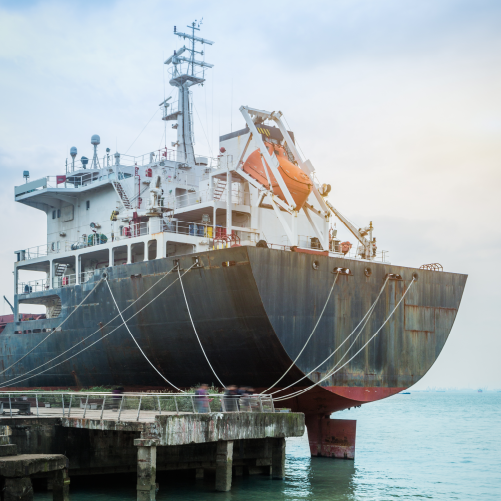Shipping Applications
Shipping
Long and intricate suppliers and the criticality of tracing every component in this long chain makes permanent marking a crucial necessity of the shipping industry. The industry is vulnerable to disasters and uses multiple metal surfaces from stainless steel to aluminium to titanium requiring precision marking techniques to trace components. Laser marking is key to the shipping industry as the parts meet highest standards of quality and safety and the marking should be readable to the human eye as well as scanners.
Surfaces For Marking
Day and night markings on avionic panels |micro and major electrical, mechanical and electronic constituents | Chips, circuit boards and other navigation devices | wings and blades | thrusters and actuators | branding and bar coding on exteriors

In the shipping industry, dot peen marking machine and laser marking machines are widely used for various applications related to part identification, traceability, and compliance with international regulations. These technologies play a crucial role in ensuring the visibility, durability, and traceability of markings on components and equipment used in the maritime sector. Here’s an overview of how dot peen and laser marking machines are commonly used in the shipping industry:
### Dot Peen Marking:
- Marking Process:
– Dot peen marking involves using a stylus to create a series of small, closely spaced dots on the surface of a material, forming alphanumeric characters, logos, or other symbols.
- Materials:
– Dot peen is suitable for marking various materials used in the shipping industry, including metals, alloys, and coated surfaces.
- Applications:
– Part and equipment identification on ship components.
– Serial numbers for traceability.
– Date codes, lot numbers, and other alphanumeric markings.
– Compliance with maritime standards and regulations.
- Advantages:
– Durable and indelible markings.
– Well-suited for harsh marine environments, including exposure to saltwater and weather conditions.
– Cost-effective for certain applications.
– Compliance with industry-specific marking requirements.
### Laser Marking:
- Marking Process:
– Laser marking involves using a laser beam to modify the surface of a material, creating high-contrast and permanent marks without physical contact.
- Materials:
– Laser marking is versatile and can be applied to a wide range of shipping industry materials, including metals, plastics, ceramics, and coated surfaces.
- Applications:
– 2D matrix codes for part tracking.
– Component serialization for traceability.
– Fine and detailed markings for branding and logos.
– Compliance with maritime standards and regulations.
- Advantages:
– High precision and fine detail.
– Non-contact process, reducing wear on equipment.
– Flexibility in terms of design and customization.
– Suitable for applications in controlled environments.
### Integration in Shipping Operations:
- Regulatory Compliance:
– Both dot peen and laser marking technologies are crucial for meeting international maritime standards and specifications related to part identification, traceability, and durability.
- Quality Assurance:
– Markings serve as a quality control measure, ensuring that each component or piece of equipment meets the maritime industry’s stringent requirements.
- Traceability:
– The ability to trace components throughout their lifecycle is essential for maintenance, repair, and ensuring the reliability of maritime systems.
- Durability in Harsh Marine Environments:
– Both technologies are chosen for their ability to provide durable markings that can withstand harsh marine conditions, including exposure to saltwater, humidity, and environmental elements.
In summary, dot peen and laser marking machines are integral to the shipping industry, offering solutions for part identification, traceability, and compliance with international standards. The choice between the two technologies depends on specific material requirements, precision needs, and the environmental conditions in which the marked components will be used.


